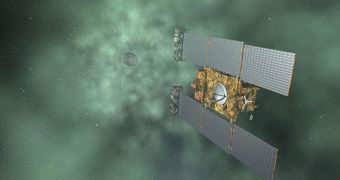After waiting for more than three and a half years for this occasion, experts at NASA finally got what they wanted yesterday. The Stardust-NExT space mission caught up with comet 9P/Tempel 1 on February 14, and snapped a series of high-resolution images of its surface.
The space probe has been traveling through the inner solar system for quite some time now. Over the years, it manged to meet up with the comet Wild 2, and carry out a sample-return mission on it.
It also flew past the large asteroid Annefrank, but then was put on standby for a while. Finally, missions controllers reactivated it when it became apparent that comet Tempel 1 is within reach.
Calculations showed that the two could meet on February 14, 2010, and so experts at the NASA Jet Propulsion Laboratory (JPL), in Pasadena, California, decided to go for it.
The main rationale behind the new flyby was surveying a crater created on the surface of the comet back in 2005. At the time, the NASA Deep Impact space probe dropped a large impactor on Tempel 1.
Due to the ensuing plume of dust and gas, the spacecraft could not analyze the crater in detail. But the JPL team hopes that Stardust-NExT has what it takes to complete what was started 6 years ago.
There is however no way of knowing what the probe will downlink. The JPL crew says that the entire spacecraft could pass through unexpected eruptions originating from the surface of the comet.
Tempel 1 sometimes spews out plumes of dust and ice particles, and these events happen suddenly. If the probe is engulfed in one of them, then all of its detectors could be blinded.
But the NASA team is hopeful that this will not be the case. The flyby already occurred on time, and it's now time to wait for the data Stardust-NExT sent to reach our planet.
“It is expected that images of the comet's nucleus collected during the flyby will be received on Earth starting at about midnight California time (3 am EST on Tuesday, February 15),” JPL experts say.
“An hour after closest approach, the spacecraft turned to point its large, high-gain antenna at Earth. Preliminary data already transmitted from the spacecraft indicate the time of closest approach was about 8:39 pm PST, at a distance of 181 kilometers (112 miles) from Tempel 1,” they add.
The probe collected about 72 high-resolution images of the comet, and so the JPL mission controllers hope that at least some of them show the Deep Impact crater, or other interesting features of the space body.

 14 DAY TRIAL //
14 DAY TRIAL //